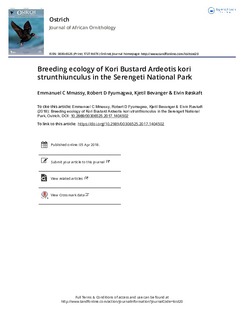Breeding ecology of Kori Bustard Ardeotis kori strunthiunculus in the Serengeti National Park
Journal article, Peer reviewed
Accepted version

Åpne
Permanent lenke
http://hdl.handle.net/11250/2493915Utgivelsesdato
2018Metadata
Vis full innførselSamlinger
- Publikasjoner fra CRIStin - NINA [2364]
- Scientific publications [1392]
Originalversjon
10.2989/00306525.2017.1404502Sammendrag
The breeding ecology of the Kori Bustard Ardeotis kori strunthiunculus was studied in the plains of the Serengeti National Park, Tanzania in 2014 and 2015. Random transects were used to search for male courtship displays, nests, chicks and subadults. GPS satellite collars were used to locate nesting females. Linear regression analyses and post hoc tests were used to determine the predictors that contributed most to the variation of the dependent variables (courtship display, nest, chicks and subadults). The results indicate that courtship behaviour peaks during the short dry and short rainy season before the peaks in nests and chicks. The highest nest frequency was found in short grass habitats. Female Kori Bustard may undergo repeated nestings within a single breeding season. The adult sex ratio was female skewed during the breeding season. The Kori Bustard breeding season in the Serengeti plains is relatively long, lasting for almost nine months, and taking place during all seasons except for the long dry season. We recommend that management authorities conduct assessments of Kori Bustard recruitment as well as habitat suitability in the Serengeti ecosystem to develop future conservation strategies. breeding, habitat, season, Serengeti plains, sex ratio Écologie de reproduction de l’Outarde Kori Ardeotis kori strunthiunculus dans le Parc National de Serengeti